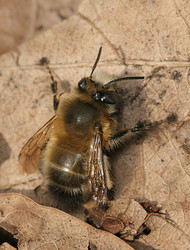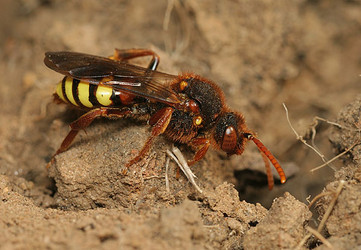Apidae
Carpenter bees, cuckoo bees, honey bees, etc.



This tree diagram shows the relationships between several groups of organisms.
The root of the current tree connects the organisms featured in this tree to their containing group and the rest of the Tree of Life. The basal branching point in the tree represents the ancestor of the other groups in the tree. This ancestor diversified over time into several descendent subgroups, which are represented as internal nodes and terminal taxa to the right.

You can click on the root to travel down the Tree of Life all the way to the root of all Life, and you can click on the names of descendent subgroups to travel up the Tree of Life all the way to individual species.
For more information on ToL tree formatting, please see Interpreting the Tree or Classification. To learn more about phylogenetic trees, please visit our Phylogenetic Biology pages.
close boxReferences
Brothers, D. J. 1999. Phylogeny and evolution of wasps, ants and bees (Hymenoptera, Chrysidoidea, Vespoidea and Apoidea). Zoologica Scripta 28 (1-2): 233-249.
Engel, M. S. 2001. A monograph of the Baltic Amber bees and evolution of the Apoidea (Hymenoptera). Bulletin of the American Museum of Natural History 259: 1-192.
Melo, G. A. R. 1997. Phylogenetic Relationships and Classification of the Major Lineages of Apoidea (Hymenoptera), with Emphasis on the Crabronid Wasps. Unpublished doctoral Dissertation, University of Kansas, Lawrence.
Plant, J. D. and Paulus, H. F. 1987. Comparative morphology of the postmentum of bees (Hymenoptera: Apoidea) with special remarks on the evolution of the lorum. Zeitschrift für zoologische Systematik und Evolutionsforschung 25: 81-103.
Roig-Alsina, A. and Michener, C. D. 1993. Studies of the phylogeny and classification of long-tongued bees (Hymenoptera: Apoidea). University of Kansas Science Bulletin 55: 124-162.
Title Illustrations

| Scientific Name | Anthophora plumipes |
|---|---|
| Location | UK |
| Specimen Condition | Live Specimen |
| Sex | Male |
| Source | Anthophora plumipes (m) |
| Source Collection | Flickr |
| Image Use |
 This media file is licensed under the Creative Commons Attribution-NonCommercial-NoDerivs License - Version 2.0. This media file is licensed under the Creative Commons Attribution-NonCommercial-NoDerivs License - Version 2.0.
|
| Copyright | © 2007 Tristan |
| Scientific Name | Nomada lathburiana |
|---|---|
| Location | UK |
| Specimen Condition | Live Specimen |
| Sex | Female |
| Source | Nomada lathburiana (f) |
| Source Collection | Flickr |
| Image Use |
 This media file is licensed under the Creative Commons Attribution-NonCommercial-NoDerivs License - Version 2.0. This media file is licensed under the Creative Commons Attribution-NonCommercial-NoDerivs License - Version 2.0.
|
| Copyright | © 2007 Tristan |
| Scientific Name | Andrena cineraria |
|---|---|
| Location | UK |
| Specimen Condition | Live Specimen |
| Source | Andrena cineraria (m) |
| Source Collection | Flickr |
| Image Use |
 This media file is licensed under the Creative Commons Attribution-NonCommercial-NoDerivs License - Version 2.0. This media file is licensed under the Creative Commons Attribution-NonCommercial-NoDerivs License - Version 2.0.
|
| Copyright | © 2007 Tristan |
About This Page
Page copyright © 2004
All Rights Reserved.
- First online 19 March 2004
Citing this page:
Tree of Life Web Project. 2004. Apidae. Carpenter bees, cuckoo bees, honey bees, etc.. Version 19 March 2004 (temporary). http://tolweb.org/Apidae/22101/2004.03.19 in The Tree of Life Web Project, http://tolweb.org/











 Go to quick links
Go to quick search
Go to navigation for this section of the ToL site
Go to detailed links for the ToL site
Go to quick links
Go to quick search
Go to navigation for this section of the ToL site
Go to detailed links for the ToL site